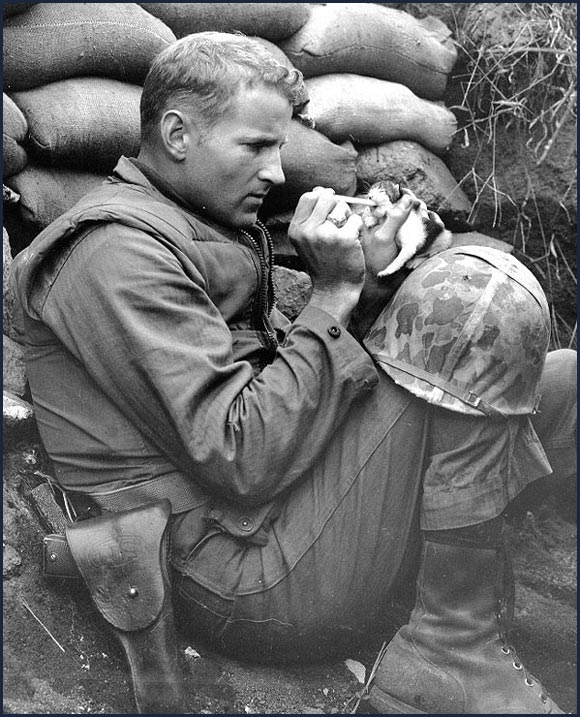Bill Edwards-Bodmer considers ship mascots and fascinating photos of animals at war in this image-packed article.
Capturing a moment of extraordinary compassion and tenderness during the violence and bloodshed of the Korean War, the above well-known image demonstrates the remarkable relationship that often existed between animals, and the soldiers and sailors who wage war. Besides the millions of horses who served in cavalry units throughout history, military units and navy ships often adopted animals as mascots. Sailors and marines in particular have a long history of sharing their cramped lives aboard ships with animals.
Cats were one common animal. Mariners in ancient Egypt were known to keep cats aboard their vessels for the vital service the felines provided: ridding the ships of rats and mice that would otherwise eat and destroy provisions, cargo and other supplies and spread disease. Sailors throughout history also believed cats brought good luck, as well as amusement during long voyages. They also adopted cats from the foreign ports they visited.

Sailors on USS Nahant playing with two cats, circa 1898.

Two US Navy pilots playing with a cat while serving in the Pacific during World War II.
Dogs also have a long history of serving at sea. On ships, especially naval vessels, dogs were kept to provide much needed companionship and to boost moral during long, monotonous journeys. Naval crews adopted these dogs as the ship’s mascot. Countless images exist of sailors proudly posing with their ship’s mascot, so showing the positive effect that dogs had.

Crew of USS Hunchback during the American Civil War. The crewman to the left of the man holding a newspaper is with a small dog.

Sailor with “Mike,” mascot of USS New York, circa 1899.

“Salty,” the mascot of a Coast Guard destroyer escort, circa 1943.

“Blackout,” the mascot of a Coast Guard LCI, circa 1944.

US Marine private takes a nap with his division’s mascot while on Okinawa, 1945.

“Sinbad,” mascot on Coast Guard cutter Campbell, circa 1944.
Besides dogs and cats, more unusual and exotic animals were often adopted as mascots. These animals were usually given as gifts to visiting ships at ports by local officials. This was notably seen on the ships of the famous Great White Fleet of the United States Navy during its world cruise of 1907-1909. The mighty battleships of the US fleet received everything from kangaroos to eagles to bears. Some animals didn’t work out so well: monkeys given to sailors on one of the ships escaped their enclosures and made a home among the smokestacks, biting anyone who tried to catch them (source: steelnavy.org).

Sailors with a goat mascot during the Great White Fleet world cruise, circa 1907-1908.

Pig mascot of USS Connecticut, circa 1908.

Eagle presented to USS Connecticut during the Great White Fleet’s world cruise, circa 1908.

The citizens of Seattle, Washington presented a bear cub to USS Missouri when that ship visited in 1908 as part of the Great White Fleet world cruise.

Feeding a bear mascot on board the USS Connecticut during the Great White Fleet cruise, circa 1908.

The citizens of Sydney, New South Wales, Australia presented USS Connecticut with a kangaroo when that ship visited in 1908 during the Great White Fleet’s world cruise.

Lieutenant John E. Lewis with a kangaroo on board USS Connecticut, circa 1908.
These images provide a light-hearted view of past life in the United States Navy and Marine Corps, and show the special bond that could exist between animals and the sailors and marines who cared for them.
If you enjoyed the article, tell the world! Like it, tweet about it, or share it by pressing one of the buttons below…
